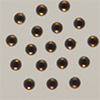| Sep 30, 2022 |
|
(Nanowerk News) research team led by the GRASP – Group of Research and Applications in Statistical Physics – at the University of Liège (Belgium), demonstrates how to manipulate the mesh, shape and symmetry of floating crystals by wandering, in a controlled way, between their metastable states. This study is published in the journal Scientific Reports (“Controlled transitions between metastable states of 2D magnetocapillary crystals”).
|
 |
| Different assemblies of N particles on the surface of the liquid. For each number N of particles, two different assemblies are shown opposite each other, demonstrating the metastability of the assembly. (Image: ULiège)
|
|
Multi-particle systems are of interest in several areas of physics. Their structure is governed by their interactions. In particular, in the presence of attractive interactions, these systems tend to self-assemble, minimizing their energy. This phenomenon exists at all scales, governing the formation of molecules and planetary systems. Depending on the complexity of the interactions, particles can form simple periodic structures (crystals), or more complex ones like protein chains.
|
|
Magnetocapillary interactions between particles allow self-assembly of floating crystals along liquid interfaces. For a fixed number of particles, different states with different symmetric characteristics, called metastable states, coexist. Various pioneering works have observed the existence of metastable states in floating crystals. As different states coexist, it is difficult to control the formation of specific structures.
|
|
However, controlling the formation of metastable states is a key ingredient to functionalize such assemblies, paving the way for self-assembling microrobots for example. The way to control the state of a floating crystal has never been studied before.
|
|
Self-assembly has attracted the interest of academia and industry because of its use to fabricate tiny structures,” says Nicolas Vandewalle, professor of physics and director of GRASP. Indeed, some structures are too large to be prepared by chemical synthesis and too small to be assembled by robotic methods. In particular, the micrometer-millimeter scale is usually the bottleneck between standard bottom-up and top-down manufacturing methods.”
|
|
One of the main characteristics of self-assembled systems is that due to the high number of degrees of freedom, there are often several local minima in addition to the global minimum energy state. These metastable states can be observed at all scales, at the molecular level, in colloids, at the mesoscopic scale and at the macroscopic scale. Interest in how to exploit these metastable states for active structuring has recently increased. Therefore, a fundamental question, which the researchers addressed in this study, is to define the conditions for navigating between the different metastable states.
|
 |
| Animation of the growth of a floating crystal from N=3 to N=19 particles. Particles are added one by one to the surface of the liquid under magnetic field. The attractive capillary forces are counterbalanced by the repulsive magnetic forces. The assembly shows a symmetry typical of atomic crystals. (Image: ULiège, N.Vandewalle)
|
|
“In the study we have just published,” says Ylona Collard, a researcher at GRASP and first author of the article, “we studied magnetocapillary self-assemblies composed of 3 to 19 particles. For a fixed number of particles composing the assembly, several different states coexist, distinguished by their shape, mesh size and symmetry. The researchers proposed two different, but complementary, experimental techniques to navigate in a controlled manner between these different states. The first allowed a change of state for a fixed number of particles. This is achieved by applying a horizontal magnetic field that induces a deformation of the assembly. After relaxation, the assembly will have changed state with a certain probability. The second technique controls the growth of an assembly by choosing the desired state for an assembly of N (number) + 1 beads from an assembly of N beads. An infrared laser is applied to the water surface to generate thermocapillary fluxes, controlling the trajectory of the new bead added to the system.”
|
|
“Models have been proposed to study the frequency of occurrence of the different states of an assembly at its creation,” explains Nicolas Vandewalle, “and to model the two experimental techniques. The simulations are in very good agreement with the experimental results. An analogy between these magnetocapillary assemblies, which can be reduced to a smaller size scale, and colloidal crystals has been proposed to broaden the perspectives of this work.”
|
|
This work is indeed relevant for the fabrication of microscopic structures such as electronic circuits, microrobots or new materials with new physical properties.
|



